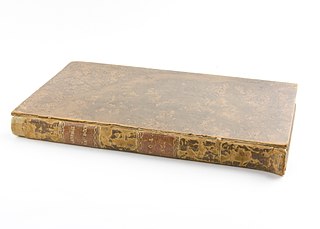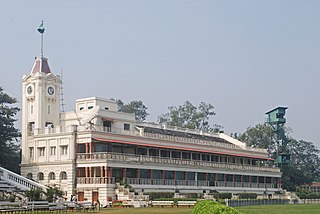
Thoroughbred racing is a sport and industry involving the racing of Thoroughbred horses. It is governed by different national bodies. There are two forms of the sport – flat racing and jump racing, the latter known as National Hunt racing in the UK and steeplechasing in the US. Jump racing can be further divided into hurdling and steeplechasing.

Horse racing is an equestrian performance sport, typically involving two or more horses ridden by jockeys over a set distance for competition. It is one of the most ancient of all sports, as its basic premise – to identify which of two or more horses is the fastest over a set course or distance – has been mostly unchanged since at least classical antiquity.

The Victoria Racing Club was founded in 1864. It was formed following the disbanding of the Victoria Turf Club and the Victoria Jockey Club. A legacy passed from the Victoria Turf Club was the annual "race that stops a nation", the Melbourne Cup, which was first contested in 1861.

Thoroughbred horse racing is a spectator sport in Australia, and gambling on horse races is a very popular pastime with A$14.3 billion wagered in 2009/10 with bookmakers and the Totalisator Agency Board (TAB). The two forms of Thoroughbred horseracing in Australia are flat racing, and races over fences or hurdles in Victoria and South Australia. Thoroughbred racing is the third most attended spectator sport in Australia, behind Australian rules football and rugby league, with almost two million admissions to 360 registered racecourses throughout Australia in 2009/10. Horseracing commenced soon after European settlement, and is now well-appointed with automatic totalizators, starting gates and photo finish cameras on nearly all Australian racecourses.

The Breeders' Cup World Championships is an annual series of Grade I Thoroughbred horse races, operated by Breeders' Cup Limited, a company formed in 1982. From its inception in 1984 through 2006, it was a single-day event; starting in 2007, it expanded to two days. All sites have been in the United States, except in 1996, when the races were at the Woodbine Racetrack in Canada.

Racing Victoria Limited, as the governing principal racing authority, has responsibilities to develop, encourage, promote and manage the conduct of Thoroughbred horse racing in the State of Victoria, Australia. It assumed this responsibility, from the Victoria Racing Club, on 19 December 2001.
The Australian and New Zealand punting glossary explains some of the terms, jargon and slang which are commonly used and heard on Australian and New Zealand racecourses, in TABs, on radio, and in the horse racing media. Some terms are peculiar to Australia, such as references to bookmakers, but most are used in both countries.

Ajax was a champion Australian bred Thoroughbred racehorse and sire, who won 18 consecutive races before he was defeated at the odds of 40/1 on, causing a huge racing sensation. He had wins from 5 furlongs (1,000 metres) to 1½ miles (2,400 metres), equalled the Australasian record for a mile (1,600 metres), and created three new race records. At stud in Australia, Ajax proved to be a good sire. He was then sold as a 14-year-old horse and exported to the United States before he was later sold to Bing Crosby and Lin Howard. Ajax was inducted into the Australian Racing Hall of Fame in 2004.

Leamington (1853–1878) was a champion American Thoroughbred racehorse and an influential sire in the United States during the second half of the nineteenth century.

Harness racing, also colloquially known as trotting or the trots, is a spectator sport in Australia, with significant amounts of money wagered annually with bookmakers and the Totalisator Agency Board (TAB). In Australia there are 90 harness racing tracks, which hold over 1,900 meetings annually. There are approximately 2,900 drivers and 4,000 trainers with about 5,000 Standardbred horses foaled and registered each year.
Racing and Wagering Western Australia, or RWWA is a controlling authority for thoroughbred, harness and greyhound racing in the state of Western Australia.

The Thoroughbred is a horse breed developed for horse racing. Although the word thoroughbred is sometimes used to refer to any breed of purebred horse, it technically refers only to the Thoroughbred breed. Thoroughbreds are considered "hot-blooded" horses that are known for their agility, speed, and spirit.

The Jersey Act was introduced to prevent the registration of most American-bred Thoroughbred horses in the British General Stud Book. It had its roots in the desire of British horse breeders to halt the influx of American-bred racehorses of possibly impure bloodlines during the early 20th century. Many American-bred horses were exported to Europe to race and retire to a breeding career after a number of U.S. states banned gambling, which depressed Thoroughbred racing as well as breeding in the United States. The loss of breeding records during the American Civil War and the late beginning of the registration of American Thoroughbreds led many in the British racing establishment to doubt that the American-bred horses were purebred.

Sailor's Guide was an outstanding Thoroughbred racehorse that was conceived in England and foaled in Australia. He is notable in that he won races in the United States, Canada, and a number of principal Australian races, and was a high stakes earner.
The Western Australian Turf Club (WATC), later known as Perth Racing, was established in late nineteenth century as an elite social institution and administrator of the Western Australian horse racing industry. They manage two racecourses in Perth, Ascot Racecourse and Belmont Park Racecourse.

The Australian Stud Book (ASB), is the body responsible for ensuring the integrity of Thoroughbred breeding in Australia. Australia is the second-largest Thoroughbred breeding country in the world behind the US. The principal functions of the ASB include identification procedures along with DNA testing of mares and foals and the recording of a mare’s progeny and stallion statistics. In 2003 the ASB introduced microchips for foals, which is the most secure means of horse identification when and combined with freeze branding, provides racing officials with the most dependable identification system in the world.

Sweetmeat was a successful English Thoroughbred racehorse that won 16 consecutive races as a three-year-old, including the Doncaster Gold Cup, and was a useful sire of the early 19th century.

The Royal Calcutta Turf Club (RCTC) is a horse racing organisation which was founded in 1847 in Calcutta, British India. Horse events and sports were initially organised for the British cavalry at Akra before they were moved to the Maidan. The RCTC became the foremost horse-racing organization in India during the British Raj. At one time it was the governing body for nearly all racecourses in the subcontinent, defining and applying the rules governing the sport. During its heyday, RCTC-organised races were among the most important social events of the bigwigs' calendar and were opened by the Viceroy of India. Still a private club, the RCTC operates Kolkata Race Course in the Maidan.

Horse racing in Ireland is intricately linked with Irish culture and society. The racing of horses has a long history on the island, being mentioned in some of the earliest texts. Domestically, racing is one of Ireland's most popular spectator sports, while on the international scene, Ireland is one of the strongest producers and trainers of Thoroughbred horses. The Irish horse racing industry is closely linked with that of Great Britain, with Irish horses regularly competing and winning on the British racing circuit.

The 2021 Breeders' Cup World Championships is the 38th edition of the premier event of the North American thoroughbred horse racing year. The 14 races, all but one of which are Grade I, took place on November 5 and 6 at Del Mar Racetrack in Del Mar, California and were telecast by NBC and NBC Sports. The Breeders' Cup is generally regarded as the end of the North America racing season, although a few Grade I events take place in later November and December. The event typically determines champions in many of the Eclipse Award divisions.
















